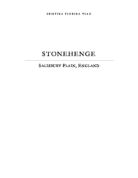Stonehenge, England
Stonehenge was built in three stages between about 3200 BC and 1000 BC. In its size, complexity, and evident importance, it is unique among Bronze Age henge monuments. An outer circle of sarsen stones once supported a continuous curving lintel which in turn enclosed a u-shaped arrangement of five trilithons (two uprights and a lintel).
The entire assemblage is surrounded by a circular ditch 104 m (340 ft) in diameter. On its inner side the ditch rises into a bank within which is a ring of 56 pits known as Aubrey holes (after their discoverer, the antiquarian John Aubrey) and used at a later stage as cremation burial pits. On the north-eastern side, the bank and ditch are intersected by the Avenue, a processional causeway 23 m (75 ft) wide and nearly 3 km (2 mi) long, bordered by a ditch. Near the entrance to the Avenue is the Slaughter Stone, a sarsen stone that may originally have stood upright. Almost opposite, and set within the Avenue, is the Heel Stone, which may have played a part in sightings of the sunrise at the summer solstice.
HISTORY
Stonehenge was built in several stages, probably beginning as a henge monument (ritual enclosure) surrounded by a bank and ditch and similar to many others in southern England. It was around 2200 BC that it took on its unique appearance, 82 bluestones being transported from the Preseli Mountains, in south-western Wales. The Altar Stone is believed to have come from a region near Milford Haven, Dyfed.
Stonehenge was undoubtedly built by a people who had widespread trade connections and who established their principal settlements in the area between 1600 and 1300 BC. Its importance is reflected by the fact that the landscape around the monument is dotted by some 400 barrows, circular mounds enclosing burials, dating from between 2000 and 1500 BC; excavation of some of these barrows has revealed rich grave goods as well as chips of bluestone similar to that found in the concentric ranges.
Stonehenge, England
Stonehenge appears to have lost its importance as a ceremonial site at the end of the Bronze Age. It was desecrated sometime between 55 BC and AD 410 by the Romans, who tore down a number of the upright stones. In addition, two uprights and a lintel west of the Altar Stone fell in January 1797, and another upright and its lintel fell in 1900. In 1958 these five stones were raised, giving the monument the approximate appearance that it had during the Roman occupation of Britain. Shallow carvings found (1953) on some of the fallen stones depict bronze axeheads of a type used in Britain between 1600 and 1400 BC and a hilted dagger of a type used in Mycenae, Greece, between 1600 and 1500 BC.
CALENDRICAL THEORY
The function of Stonehenge has long been a matter of conjecture. It could have been used to predict the summer and winter solstices, the vernal and autumnal equinoxes, and eclipses of the sun and moon. It may also have functioned as a means of predicting the positions of the sun and moon relative to the Earth, and thereby the seasons, and perhaps also as a calendar. As such it might have been the gathering place for religious ceremonies connected with the sun and moon. At Stonehenge as at other Bronze Age sites, the emphasis on the circle may also reflect the circular nature of birth and death, and the passage of the seasons.







